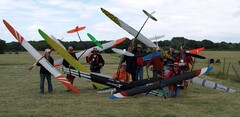
Most will know of the new development in glider construction which was pioneered by DLG model makers. The difference from what we are used to with moulded construction is that the new method uses one precision cut solid foam core rather than the several layers of thin foam used in the construction of hollow moulded wings. The solid core is covered with the, also new ultra-light carbon fabric, in a mould. There are a number of other differences in the construction but I don’t have all that info.
This new construction enables wings to be built with a much thinner section, and much lighter in weight.
I must say that when I first read of these developments I had my doubts. How could the weights be achieved, how could they be strong enough for our conditions, how could they be of any use in ‘our’ conditions.
I always have to try something new, so when Hyperflight imported a few, I took a chance and bought one of the new Ultima F5J models.
All I can say is that the hype about these gliders is true. They are fantastically light and very strong. There is nothing ‘flimsy’ about any part. With some light weight models I have seen, the fuselage is very flexible because of the light cloth and minimal amount of epoxy used. I have a standard Ultima fuselage and it is very rigid made of carbon. The wall thickness is substantial and there is nothing flimsy about it, and it also is very light.
There are a number of build threads on the web so I won’t try to compete with those. Only to say that it requires a few different techniques which are more usual to hand launch models. I did take a few pics as I put it together as below
Flap Servo

Servo Mount and Ballast Tube
Cutting nose to length after balancing the model.

Servos and ballast tube.
Traditional pic before first flight.
I have only had 6 flights with it so far, including 4 flights at the Tonbridge F5J comp where the conditions really did not suit it. But I am very pleased with what I have seen so far.
Any questions please ask away.







Recommended Comments
Create an account or sign in to comment
You need to be a member in order to leave a comment
Create an account
Sign up for a new account in our community. It's easy!
Register a new accountSign in
Already have an account? Sign in here.
Sign In Now